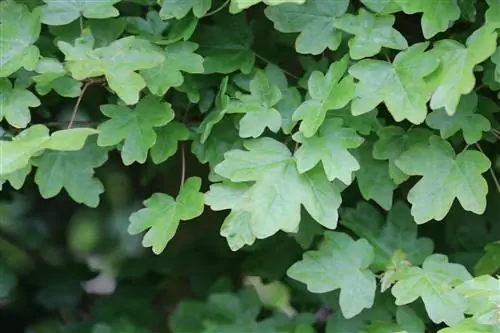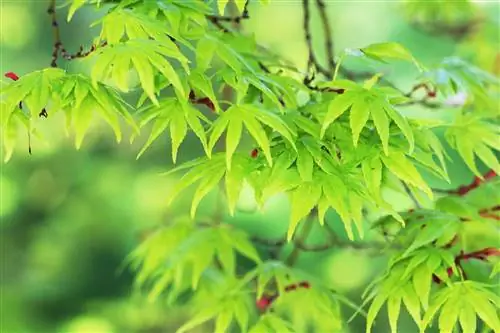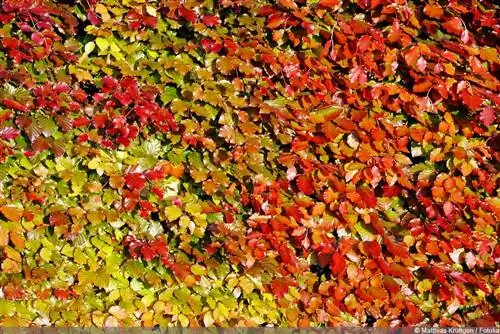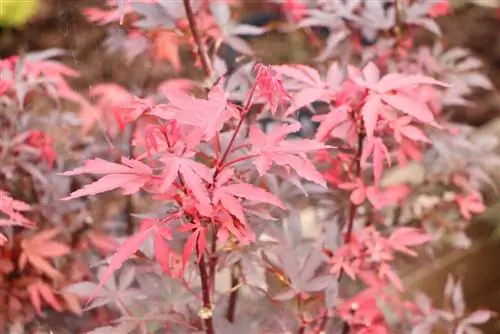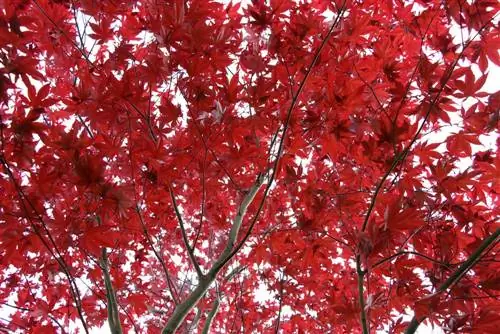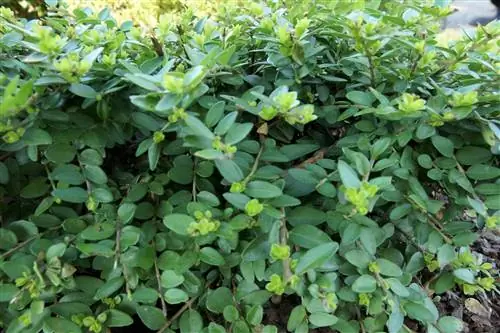- Author admin [email protected].
- Public 2023-12-17 03:39.
- Last modified 2025-01-24 12:45.
The honor of 'Tree of the Year 2015' was long overdue. The field maple has characteristics such as a dense, bush-like habit, rapid growth, easy pruning tolerance and wonderful autumn color. Thanks to an affordable purchase price, even large properties can be perfectly fenced in with a field maple hedge. With a little practice, hobby gardeners can even shape the measuring holder into an evergreen hedge gate. Read here about the aspects of planting, fertilizing and cutting that play a role in properly caring for a field maple hedge.
Profile
- Plant genus of maples (Acer)
- Name of the species: Field maple (Acer campestre)
- Summer green deciduous tree with a shrub-like habit
- Growth height without cutting: up to 15 meters
- Growth height in cultivation: 3 to 5 meters
- Annual growth: 40 to 50 centimeters
- Inconspicuous panicle blossom in May
- Bright golden-yellow to orange autumn colors
- Typical wing fruits in autumn
- Common name: Maßholder
In addition to its competence as an opaque privacy hedge, the field maple is also considered a popular nesting place for the garden's birds.
propagation by sowing
By far the cheapest method of creating a field maple hedge is to grow young plants yourself. Only the fact that germination can take up to 12 weeks could persuade hobby gardeners to buy pre-grown trees from the nursery. The sowing itself is uncomplicated. Since the seeds are cold germinators, stratification is required as an intermediate step. In concrete terms, this means exposing the seeds to a cold stimulus that simulates winter frost. This is how it works step by step:
- Place the seeds in a plastic bag with damp sand in the vegetable drawer of the refrigerator
- Remove after 8-10 days and soak in lukewarm water for 24 hours
- Fill the cultivation pots with peat sand or coconut fibers and plant one or two seeds 2-3 centimeters deep in each one
- Moisten the substrate and pull a cling film over the pot
- Keep constantly moist on a warm, partially shaded windowsill and ventilate regularly
After germination there is no need for a cover. Furthermore, keep the seedlings slightly moist and do not expose them to the blazing sun. From a height of 40-60 centimeters, a field maple is mature enough to be planted outdoors.
Tip:
With a growth height of 60-80 centimeters, the plant requirement for a dense field maple hedge is 3 trees per linear meter.
Location
A Maßholder has hardly any demands on the site conditions. A sunny to semi-shady location is ideal, because the tree thrives poorly in a constantly dark place.
- Variably dry, clayey soil
- Nutritional, humic and loose
- Preferably calcareous to neutral
Thanks to its heart root system, the maple species also thrives in dry, nutrient-poor locations. There the shrub-like trees then branch out more widely.
Plants
The field maple trees that have been grown or purchased ready-made can be planted in containers all year round. The best time to create a field maple hedge is early autumn. Before the trees are placed in the ground, the root ball should be soaked with water. In the meantime, the soil is thoroughly loosened and cleaned of coarse particles. It is advisable to tension cords for orientation to ensure that the hedge runs in a straight line. This is how it continues:
- Dig planting holes with twice the volume of the root balls
- Enrich the excavation with horn shavings, sand and sifted compost
- In damp areas, create a drainage system made of gravel or chippings at the bottom of the pit
- Next to each planted field maple, drive in a support post and connect it with raffia tape
- Insert the field maple as deep as it was before and tamp down the soil
After the hedge plants have been watered extensively, a mulch layer of leaf mold, compost or grass supports their growth. The soil remains uncovered within 10 centimeters of the root collar. In the first few weeks after planting, the hedge is watered abundantly. Well-grown field maple makes do with the natural rainfall and is only watered when the summer is dry.
Fertilize
The rapid growth of up to half a meter per year costs the field maple energy. A regular supply of nutrients is therefore recommended. If you prefer to use slow-release fertilizer, administer one dose each in March and July according to the manufacturer's instructions. You can optionally pamper the field maple hedge regularly with compost and horn shavings until August/September. The application of fertilizer ends in late summer so that no new shoots are attracted, which can no longer ripen before winter and freeze.
If you leave the autumn leaves lying where they are, you can give your maple hedge a warming layer of mulch, which at the same time releases valuable nutrients into the soil. Especially during the first winter, freshly planted massholders are grateful for this careful care measure.
Tip:
Mineral long-term fertilizer, such as blue grain, must never be applied to dried out soil. Therefore, water the Maßholder hedge thoroughly before distributing the fertilizer grains.
Cutting
So that the strong-growing field maple hedge maintains its dense habit and does not become bare from below or within, it is cut regularly. The focus is on the right time and the appropriate incision. Here's how to do it:
- When there are no leaves, the main pruning takes place in February/March on a frost-free day
- Thoroughly thin out the entire hedge by removing all dead wood
- Cut off visibly stunted and frozen branches at the base
- Remove crossing or inward-facing branches
- Then trim the field maple hedge to the desired length
- A pyramidal shape with a wide base and narrower crown is advantageous
- If possible, make every cut just above a bud
Following St. John's shoots at the end of June, the accurate appearance fell victim to rapid growth. Now there's nothing wrong with another topiary. When doing summer pruning, please note that it does not take place under direct sunlight. If you no longer like the appearance of the maple hedge in September, use the hedge trimmers a third time in the second half of the month.
The remarkable tolerance to pruning paves the way for significantly reducing an overly grown growth hedge. A radical pruning is generally carried out during winter dormancy, ideally in February on a frost-free day. Even after a rejuvenation cut to a height of 50 or 60 centimeters, the field maple hedge willingly sprouts again.
Tips for care and cutting
The field maple grows to meters high if it is allowed to grow, but tolerates pruning very well, so that the hedge can be kept at any desired height and width. The best times for pruning are spring and autumn. This regular cutting causes the branches to form new branches, so that the hedge becomes very dense over time. If you cut straight after summer, you should check beforehand whether there are still bird nests in the hedge that are still being used.
It is also best to only prune on days with overcast skies so that the leaves, which are exposed to direct sunlight after pruning, do not burn. Normally one cut per year is sufficient, but because the field maple grows very quickly under good conditions, it can also be cut twice per year. Winter protection is not necessary for the field maple because it is very hardy.
Conclusion
Field maple is ideal as a hedge plant thanks to its beneficial properties. The rapidly growing maple species with a dense, shrub-like habit quickly takes on a powerful, opaque silhouette. The focus of care here is cutting up to three times a year to maintain shape and vitality. A regular dose of compost provides the energy required for magnificent growth. Apart from the weeks after planting, Maßholder is content with natural rainfall to regulate its water balance. All in all, the field maple deserves the title of 'Tree of the Year 2015'.

